
RHS301:
Module 1: Introduction to the Person and Profession
Module 1: Introduction to the Person and Profession
Module Introduction
This module starts with a warm welcome from the instructor, and then moves on to introduce you to the course and the main objectives. After reviewing the tips and suggestions for being a successful online student, the module continues to provide an overview of the areas that will be covered in the course, including: what is counseling, what is a helping professional, overview of counseling microskills, a summary of major counseling theories, and the brief introduction of possible settings and people that will be encountered by helping professionals.
Students will also learn about pertinent issues faced by novice counselors and ways to approach these issues.
Module Objectives
By the end of this module, you should be able to
- list the necessary skills to be a good helper and maintain a healthy therapeutic alliance<
- list skills and theories to be learned
- recall settings where helping professionals may work and use counseling skills and theories
- discuss issues new professionals face and ways to work through these issues
Reading/Planning
Complete the assigned readings listed in the Course Schedule before going through the rest of the module.
Course Introduction
Hello everyone, and welcome to RHS 301: Introduction to Counseling as a Profession. I am very excited to have you on this journey this semester as we explore the world of counseling. Throughout the class, you will learn about the key values needed to be an effective counselor or other human service professional, the importance of ethical behavior and codes, and multicultural competency skills. You will spend much of your time learning and practicing the basic skills of helping, the counseling microskills, and the major theoretical approaches to counseling along with their interventions. You will then spend the last portion of the class exploring the possible settings and people encountered by helping professionals.
I hope you find this class thought-provoking, challenging, and fun. I expect for you to leave this course with a better understanding of the counseling process, ways to implement skills and techniques into your field, the major responsibilities of counselors and other helping professionals, and the major issues affecting the helping profession today. Finally, I hope this course will answer some of your questions (and challenge you to begin asking new questions!) about your interest in helping others promote change, as well as your beliefs about how people change. Questions may include
- What are the causes of psychological problems, dysfunction, and/or pathology?
- What makes for successful therapy?
- How do people make meaningful changes in their lives and maintain a healthy quality of life?
Counseling is a difficult term to define due to its broad meanings. On the one hand, there is the profession of counseling, in which a person studies and becomes licensed as a professional counselor. However, on the other hand, there is a general meaning for counseling, in which people across a wide variety of disciplines and educational levels may serve as counselors throughout the day. These are people from across the helping professions (counseling, psychology, social work, occupational or physical therapy, nursing, education, and human resources) who rely on the use of effective communication and problem-solving skills to help others. As students in this class come from a variety of majors and backgrounds and the purpose of this course is to introduce you to the counseling profession, we will focus on the general meaning of counseling and use the terms helping profession and helping professional.
This course is divided into three parts. Part 1 is your foundation, discussing microskills. This first part of the course will introduce you to what counseling is and will describe the personal and professional aspects of what makes for a good helping professional. You will learn about
- the importance of self-awareness of your own values and biases,
- genuineness,
- empathy,
- having a non-judgmental attitude,
- multicultural competencies,
- ethical principles and codes, and
- the counseling microskills necessary to be an effective helping professional.
Once you have an understanding of the foundations of counseling and have been able to practice the counseling microskills, in Part 2 of this class you will explore some of the major theories used in counseling. There is an endless list of theories, making it impossible to cover them all. This course will focus on some of the most common theories used in practice, including psychoanalysis, Adlerian theory, behavioral theory, cognitive theory, cognitive behavioral theory, and the humanistic theory. You will also learn about some of the techniques that each of these theories use.
For Part 3, you will learn about some forms of testing and assessment that lead to diagnosis, as well as some of the major therapeutic settings in which helping professionals may work, including schools, mental health agencies and other community organizations, and hospitals. You will also learn about some of the people that helping professionals may interact with, including children, teens, adults and the elderly, families, people with disabilities or mental health conditions, and people with substance-use disorders.
Course Objectives
This course is designed to introduce you to various aspects of counseling, including the major theories and skills upon which it is founded, the interventions it uses, the diverse settings and populations it serves, and the research in which it is grounded. In addition, this course will provide an introduction to ethical issues to provide you with a broad understanding of the field. While you will gain an overview of counseling as a profession and therapeutic process, this course is not designed to teach you how to conduct therapy. The intention is to challenge you to increase your personal self-awareness, sensitivity, and competence to communicate in authentic and sensitive ways to better connect and communicate with others from diverse backgrounds.
The following are the major course objectives:
- Describe the major counseling theories.
- Compare major theories in terms of their underlying processes and techniques.
- Apply theories to real-world situations.
- Describe counseling skills and interventions.
- Apply counseling skills and interventions to real-world situations.
- Evaluate major counseling research in terms of methods, results, conclusions, and implications.
- Demonstrate empathy for others and establish rapport through the use of theory and skills.
- Describe ethical principles in the field of counseling, why they are important, and how they are applied to professional settings.
- Demonstrate understanding of multicultural competencies.
- Identify and challenge your own biases and be able to articulate why self-awareness of attitudes and beliefs may affect your relationship with others.
- Describe the range of occupational and post-baccalaureate educational opportunities.
Tips and Suggestions
For this class to run optimally, it is important for all students to keep this a safe environment. To ensure that this class is a safe place, please be respectful to others; be engaged, active, inquisitive, open-minded, and willing to discuss personal topics; and know that there is not one right or wrong way to approach a situation or to assist someone; rather, there are multiple possibilities. We must all remember to act in a professional, respectful, and ethical manner, keeping any personal information that is shared confidential. These skills are not only important for this class to run well, or for you as the student to do well, but are also essential for being a highly effective helping professional.
Tips and suggestions for being a successful learner in an online course follow.
Planning
- In addition to becoming familiar with the online learning environment, pay attention to the physical learning environment. Try to arrange everything ergonomically in your learning space.
- Pay close attention to the assignment due dates and check the syllabus regularly in case changes have been made by the instructor.
- Plan ahead and plan well. Do not put off quizzes or assignments until the last minute, because there is a chance that Canvas might be down when you need it the most!
Communicating
- Check your e-mail regularly, but be patient while waiting for responses.
- Always check the file size when you try to upload a file to share. The bigger the file size, the more difficult it may be to upload and download.
- Communicate with your instructor and/or classmates by e-mail, Discussions, instant messaging, or phone.
- Use courtesy in online communication and deal with conflict with respect.
Engaging
- Evaluate your own progress using the course objectives and assignments and regulate your own study pace based on this evaluation. Talk to your instructor if you encounter a problem.
- Participation is important to your learning experience in an online environment, so be confident in making contributions. Don't be afraid of making mistakes!
- Identify a way of taking notes that you would prefer: use Word, online journaling/blogging, note-taking software, bookmarking of important websites, or any other method that works well for you.
- Be aware of the resources available for help: your instructor, the World Campus HelpDesk, World Campus Student Services, Canvas Help, or a librarian.
How to Become a Good Helper
To be successful as a helping professional, it is essential to have a good therapeutic relationship, or alliance, with the person you are helping. To ensure a healthy therapeutic relationship and success, you, the helping professional, must remember that the most important tool is you! The following are skills necessary for creating a therapeutic alliance:
- having a good foundational knowledge of the counseling microskills,
- using the counseling microskills (the basic skills used in therapy, such as eye contact, body language, and questioning),
- understanding and using the counseling theories and techniques,
- knowing that there are multiple ways to help,
- being flexible in your helping style, and
- perhaps most importantly, being committed to continuous self-exploration and personal/professional development.
After all, if you as the helping professional are not committed to the continual examination of yourself and seeking out ways to grow, then how can you help others to examine themselves and be motivated to grow?
To become a good helper, you must attain certain conditions. Carl Rogers (1957), the developer of person-centered therapy, stated that helping professionals must be genuine. To be genuine means to show the real you; if you hide the real you when working with clients, your clients will hide their real selves. Genuineness also means being willing to take risks. While risk-taking can make you feel vulnerable and increase the chance of making mistakes, risk also pushes you to grow and develop as both a person and a professional. Risk is what encourages you to express your emotions, care about others, and be involved not only in your own life, but also in others' lives.
To be effective as a helping professional, it is also important not to engage in value judgements; instead, according to Rogers (1957), you should have unconditional positive regard toward a client. To do so, you must become aware of your own personal values and biases. When you strive to know your values and biases, you can then work to avoid bias and putting your values on others. Additionally, by learning your values and biases, you can assist others in developing successful goals that line up with their own values. Finally, you will be able to better manage differences between yourself and the people you serve, ensuring that you do no harm.
To become an effective helper, you must also be multiculturally competent. This requires the exploration of your own cultural norms, values, and traditions and of how they influence your thoughts, actions, feelings, and reactions toward various situations and people. You must be willing to learn about cultures and people who are different from you, seeing the world through others' eyes. What is the historical background of other cultures and people? What are the traditions, values, and expectations of others? It is important to learn how possible experiences with stereotypes, discrimination, racism, and oppression have affected individuals, groups of people, and whole communities.
Finally, all of these conditions are combined to create empathy. Empathy is the ability to accurately sense and reflect a client's thoughts, emotions, behaviors, and values. Empathy, at its best, is the combination of all the conditions discussed above, along with the effective use of microskills and theory, that demonstrates that you are truly listening to a client and truly care. As in our clients' lives, true empathetic listening in our own lives is rare. A person who has truly been heard empathetically will open up more and be more willing to make changes in his or her life. The therapeutic relationship, then, will be more likely to be successful.
Video Case Scenario 1.1
Watch the following video and think about how you would respond.
Where would you focus? Choose one of the following five options. Click on the arrow button to reveal what might result from your selection.
Reference
Rogers, C. (1957).The necessary and sufficient conditions of therapeutic personality change. Consulting Psychology, 21, 95–103.
Counseling Microskills
The counseling microskills are the foundation for being able to work effectively as a helping professional. The microskills, developed by Allen Ivey in 1971 to bridge the gap between theory and practice, help the professional fully hear and understand a person’s story. Effective use of the microskills helps to relay that you are listening and fully engaged in what the person is saying; by using them, you demonstrate empathy, genuineness, and acceptance, creating a safe environment that allows for a healthy therapeutic alliance between you and the individual.
The microskills include a variety of verbal and behavioral responses and the appropriate use of questions, all of which come together to enhance the therapeutic relationship. These skills can be combined in different ways to be used with people from varying backgrounds and in a variety of situations. The microskills are also flexible enough to be used effectively with different counseling theories.
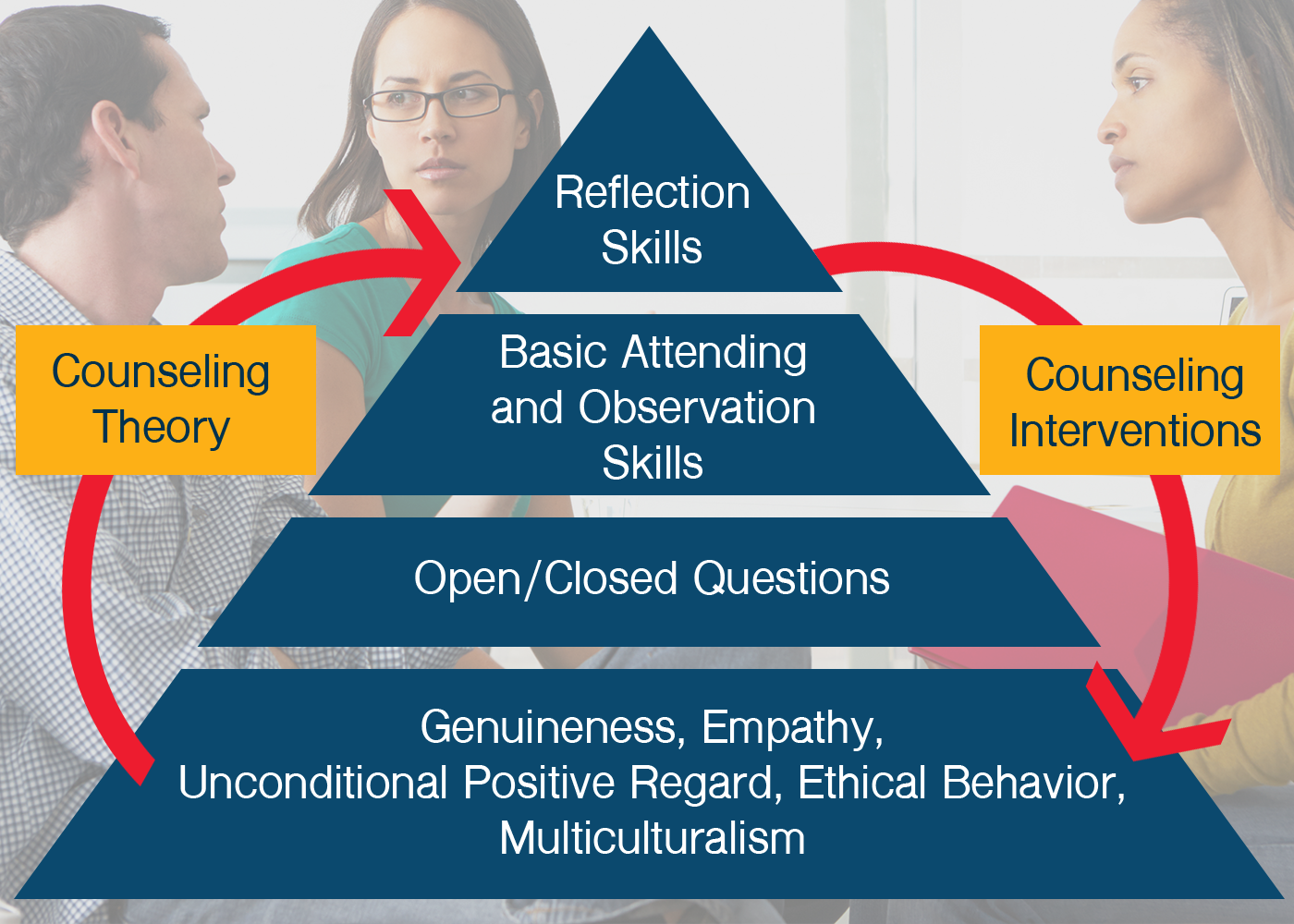
The microskills are often presented in a hierarchy (Ivey, Ivey, & Zalaquett, 2014). At the base of this hierarchy are the necessary personal and professional conditions stated by Carl Rogers (1957), including genuineness, empathy, and unconditional positive regard. Added to this foundation are ethical behavior and multicultural competencies (Ivey et al., 2014). It is important to keep in mind that if these conditions are not met, then the rest of the process will not work.
The hierarchy is only partially complete, as this course will focus mostly on basic attending and observation skills, asking questions, and reflection skills. It will spend some time on two other microskills (self-disclosure and confrontation), but they require much practice, as well as the mastery of the other skills and the personal and professional conditions that go beyond this introductory course. Intertwined throughout the hierarchy are counseling theories and interventions.
Basic Attending Skills
The basic attending skills include eye contact, vocal qualities (such as tone of voice), and verbal tracking. Verbal tracking involves keeping tabs on words or phrases that are emphasized, repeated, or even not used. Also included in basic attending skills is body language. Body language can involve your position or a client’s position in a chair or even a room, body posture, possible mirroring, and even physical barriers, such as a table or desk between you and a client.
Basic Observation Skills
Next are the basic observation skills: paying attention to not only what a client says, but also to how a client says something. For example, perhaps you experience the following situation with a client:
Video Case Scenario 1.2
Video Case Scenario 1.3
Another example would look like this:
While attending and observation skills are called basic skills, they set the stage for the more advanced skills and are necessary to master to be able to use theory and to become a highly effective helping professional. If you do not learn these essential skills, then the more advanced microskills are useless.
Open and Closed Questions
The next set of skills includes open and closed questions. Asking good questions is a primary tool for the helping professional. Well-developed and well-placed questions allow the helping professional to gather pertinent information from the client, allowing the client to be able to tell his or her full story. Good questions also open clients up to self-reflection and to becoming more aware of personal thoughts, actions, attitudes, and values.
Reflection Skills
The basic attending and observation skills and open and closed questions are used to develop the more advanced reflection skills. The reflection skills include a variety of techniques, such as encouraging, paraphrasing, feeling reflection, and summarizing. These skills are important for helping people process their logic and emotions surrounding a particular issue. The reflection skills help the client to develop a rich understanding of the issue and be able to examine the problem at hand in a more objective manner.
References
Ivey, A. E. (1971). Microcounseling. Springfield, IL: Thomas.
Ivey, A. E., Ivey, M. B., & Zalaquett, C. (2014). Intentional interviewing and counseling: Facilitating client development in a multicultural society (8th ed.). Belmont, CA: Brooks/Cole.
Counseling Theories
Counseling theories connect and organize a myriad of thoughts, research, and practice into sets of valuable guidelines for the helper to follow. Theory (and its resulting guidelines) helps to determine the cause of a problem, provide possible solutions, assist the helper in good communication, assist in the development and maintenance of a therapeutic relationship, and ensure good ethical practice. Helpers who do not rely on theory often work with no direction, develop poor goals with their clients, and fail to instill appropriate objectives and interventions. Work becomes ineffective with a trial-and-error format, risking harm to the therapeutic alliance and the client. This module will cover the following theories; click on each of the images to reveal the names of the relevant scholars and details about each theory.
The Psychodynamic Approaches
-
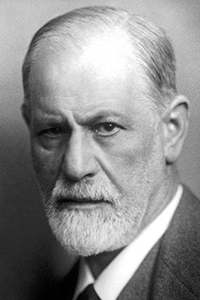
Sigmund Freud, from Wikimedia Commons" psychoanalytic theory: Psychoanalysis is based on the work of Sigmund Freud. This theory stems from the belief that our thoughts and behaviors (which combine to make our personality) develop from the tensions created by our unconscious motives and unresolved childhood issues. Freud believed that the majority of our childhood conflicts are sexual in nature and that we do not have control over the development of our personalities (further reading can be found on the American Psychoanalytic Association website). -

Alfred Adler, from Wikimedia Commons" Adlerian theory: Adlerian theory was developed by Alfred Adler, originally a student of Freud. Like Freud, Adler believed that early childhood experiences determine much of our adult personalities. However, he believed that our social relationships and their influence on us primarily help to shape personality, not psychosexual experiences. Adler further stressed that we strive to have positive social relationships and to make a difference beyond our personal spheres of influence. Adler also believed that we are personally responsible for who we are and what we do. Further reading can be found on the North American Society of Adlerian Psychology website.
Cognitive and Behavioral Approaches
-

John Watson, from Wikimedia Commons"
behavioral theory: Based on the works of Pavlov, Watson, Thorndike, Wolpe, Eysenck, Skinner, and others, behavioral theory focuses on understanding and changing individual behavior. There are several approaches categorized under this theory, but they share the overall goal of finding natural incentives (called reinforcers) that either increase positive behaviors or decrease negative behaviors. Behavioral therapists usually only focus on what can be observed and measured, not on what is felt or thought. It is believed that if observable behaviors can be changed, then thoughts and feelings will also change. Further reading can be found on the American Psychological Association's site on behavior analysis. -
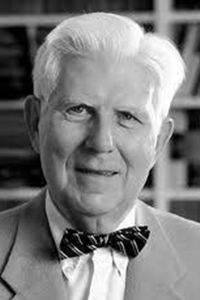
Aaron Beck, from Wikimedia Commons cognitive theory: Cognitive theory was developed by Aaron Beck, who focused on how some disorders (such as depression and anxiety) stem from what he called cognitive distortions, or errors in logic. To change these distortions, the therapist must help the individual identify the distorted thoughts and beliefs and challenge them, creating more healthy thoughts and beliefs. Further reading can be found on the Beck Institute website. -
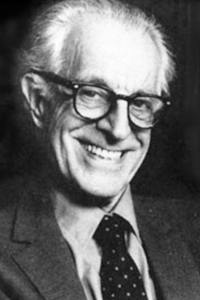
Albert Ellis, from www.nacbt.org cognitive-behavioral theory (CBT): CBT actually combines many different approaches, including rational emotive behavioral therapy (the original form of CBT developed by Albert Ellis) and dialectical behavior therapy. CBT combines a variety of strategies from both behavioral and cognitive theories, focusing on restructuring irrational thoughts, developing healthy coping strategies to decrease stress, and developing appropriate problem-solving techniques.
In rational emotive behavioral therapy, Ellis implemented the ABC model. A stands for the triggering event, B stands for the irrational beliefs we develop from the triggering event, and C stands for the resulting consequences—not from the triggering event, but from the irrational beliefs that develop. Further reading can be found on the Albert Ellis Institute website.
Humanistic Approaches
-
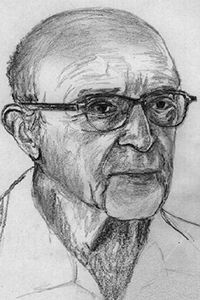
Carl Rogers, from Wikimedia Commons person-centered theory: Developed by Carl Rogers, the person-centered approach requires little technique compared to the behavioral or cognitive-behavioral approaches. What is required is that the therapist demonstrate congruence, unconditional positive regard, and empathy with the client. These three conditions help the client reach self-acceptance, increase self-worth, and reduce the divergence between the actual and ideal selves. Further reading can be found on the New York Person-Centered Resource Center website.
-
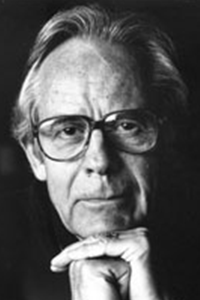
Rollo May, from www.nndb.com existential theory: Existential theory is as much a philosophy as it is a therapeutic approach. It is built on the works of such philosophers as Tillich, Heidegger, Kafka, Kierkegaard, Nietzsche, and Sartre. While the father of existential therapy is considered to be Rollo May, Victor Frankl and Irvin Yalom are also well known for their use of the theory and for contributing to the approach. The central idea is that inner conflict arises from the confrontation of existence and purpose in life. Yalom noted that death, the obtainment of freedom, personal responsibility, isolation, and meaninglessness are the ultimate concerns we constantly struggle with. The goal of therapy is to help the individual evaluate his or her life and choices, understand personal responsibility, find purpose, and be able to accept the life he or she has, as well as, ultimately, death. Frankl took the tenets of existentialism, focused on finding purpose in life, and developed logotherapy. Further reading can be found on Louis Hoffman's site on existential therapy.
Settings and Populations
People can work as counselors or provide counseling in some other form as helpers in many different settings and capacities. What is counseling, though? The term counseling is actually difficult to define, as it has very broad connotations. There is the profession of counseling, in which a person obtains the necessary education at the master’s or doctoral level and applies for licensure to become a professional counselor. However, people from a variety of professions may rely on counseling skills in the workplace.
It was not until 2010 that several counseling associations, including the American Counseling Association and the Commission of Rehabilitation Counselor Certification, came together to form the group 20/20: A Vision for the Future of Counseling. The goal of the group was to finally decide on a definition of the word counseling. They have defined counseling as
a professional relationship that empowers diverse individuals, families, and groups to accomplish mental health, wellness, education, and career goals. (Kaplan, Tarvydas, & Gladding, 2013)
With this definition in mind, people who work in settings that aim to help and empower others, called the helping professions, may include
- teachers;
- human or social service employees;
- mental health technicians or counselors;
- nurses;
- psychologists;
- physical, speech, and occupational therapists;
- physicians;
- human resource employees;
- employment specialists and career counselors;
- college advisors;
- students affairs employees;
- residential staff;
- early childcare staff;
- school counselors;
- family counselors; and
- probation officers.
People in the helping professions use counseling skills in varying degrees and at different levels. The degree to which a helping professional uses counseling skills depends on particular requirements, such as education, training, and job duties. Helping professionals can be divided into three categories, depending on education and the use of counseling skills: informal, generalist, and professional. Click on each of the accordion tabs to view details.
The Informal Helper
At an informal level, counseling skills may be used to interview people, gather basic information, provide information, or provide solutions. At this level, the helping relationship is informal and often secondary to one of the helper's other jobs. The informal helper may not have the educational training specific to counseling, but will usually have gone through employment training on how to conduct interviews, gather information, fill out necessary paperwork, and provide solutions. Informal helpers may represent the front-line staff in a human service agency, employment agency, school, or hospital office.
The Generalist Helper
The next level is the generalist helper. This is a midlevel helper who has had some education in the helping professions (often at the bachelor’s level) and has undergone extensive employment training on how to assist people. Helpers at this level will use a variety of counseling skills and theories, working more in depth in the counseling process and striving to maintain good therapeutic relationships with the people they serve. The helper at this level is working with an individual or family on facilitating lasting change. Generalist helpers can include social service workers, childcare employees, residence hall staff in a college dormitory, residential staff in a mental health setting or detention center, probation officers, nurses, and even teachers.
The Professional Helper
Finally, there are the professional helpers. These are people who have undergone extensive training at the master’s or even doctoral levels, have probably completed an extensive supervised internship, and have obtained state licensure or certification. The helper at this level has received extensive training in the use of counseling skills, theories, and interventions. Professional helpers are able to provide intensive counseling (called psychotherapy) focused on a variety of deep-seated issues. These helpers include family and marriage, clinical mental health, school, and rehabilitation counselors; general and school psychologists; social workers; psychiatric nurses; pastors; and, to some extent, psychiatrists.
Reference
Kaplan, D. M., Tarvydas, V. M., & Gladding, S. T. (2014). 20/20: A vision for the future of counseling: The new consensus definition of counseling. Journal of Counseling & Development, 92, 366–372.
The Novice Counselor
The journey of being a new helping professional can be overwhelming. The situations that new therapists may be placed into can be very stressful and filled with ambiguity. Often, as they enter practice, new professionals realize that there is a gap between coursework and what actually happens in the real world. This gap can leave new professionals feeling unprepared, further increasing stress. Common issues faced by the novice counselor include
- dealing with anxiety,
- dealing with the desire to be perfect,
- coming to terms with personal limitations,
- dealing with ambiguity,
- balancing client and agency demands,
- learning to create appropriate boundaries,
- sharing responsibilities,
- developing an identity as a professional, and
- developing a personal counseling style.
As a novice helping professional, you have to remember that you, yourself, are the most important tool you have. You have to be able to take care of you. Novice helping professionals who are unable to balance stress, develop healthy boundaries, and understand who they are as counselors will quickly experience burnout.
Read the Skovholt and Ronnstad article “Struggles of the Novice Counselor and Therapist.” After reading the article, answer the discussion questions in the associated discussion forum. Once you have posted your response, respond to two other students and then respond to one student who responded to you.
Congratulations! You’ve now completed Module 1!